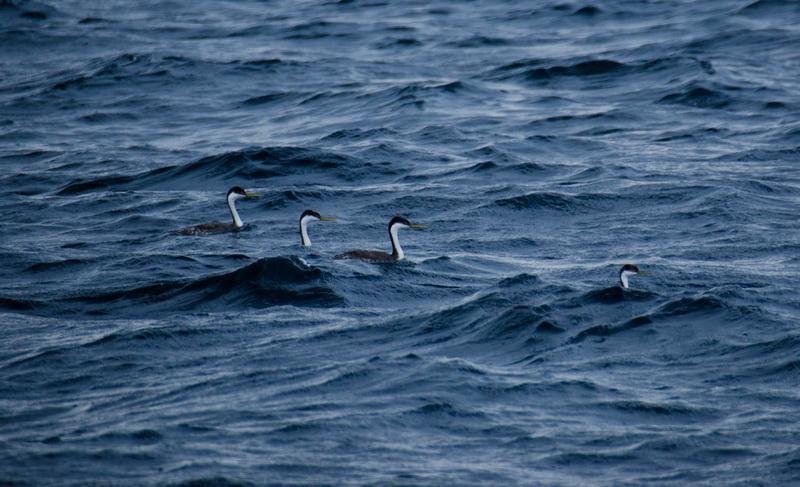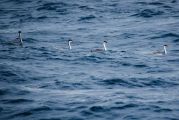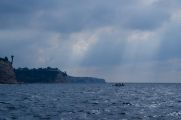By Founder and President Kurt Lieber
Under clear skies and calm seas, we headed out to a site we'd visited the week before.
It is a boundary between Palos Verdes and Santa Monica Bay.
Because there is no legal commercial hunting for lobsters in Santa Monica Bay, the commercial lobster fishermen set hundreds of traps along this border.
As we motored to the site from our slip in San Pedro, I noticed some diving birds, and we soon came across some small schools if bait fish. This is a good sign, and shows that the waters are finally cooling down a bit. One of the things that makes southern California so unique is the mixing of warm and cold water. Marine life flourishes in these areas. We saw small flocks of cormorants and pelicans. A small group of eared greebes swam by to check us out as well.
We dropped anchor in 67 feet of water, right next to the line of traps. When one looks at this lineup of traps, you can't help be wonder, "How in the world do any whales navigate through this mess without becoming entangled?" In a typical year between 12 to 14 whales become entangled (that we are aware of). This year so far, we have had 36! When you look at this scenario, and realize it is only one of many such circumstances, you realize it is an accident waiting to happen.
We soon had Kim Cardenas, Jeff Connor, Jeff Larsen, Al Laubenstein, and Bob Walls in their wetsuits; they jumped into clear water at 10 o'clock.
Jeff Larsen and Kim took off for the deep using their scooters, while Al and Bob headed to the shallower areas. Jeff Connor, took his underwater camera and swam around right under our boat to see if he could find any marine life to film.
About five minutes after all the divers were in the water, the conditions started to change. All of a sudden clouds rolled in and the waves and current started picking up. Vidia Walls (boat crew) and I were surprised by the sudden turn of events, and knew we were in for a rough ride sitting in one spot and hoping the anchor would hold.
We soon started seeing lift bags break the surface, and after about an hour of everyone being down, our divers started returning to the boat. As soon as they were all onboard we started the process of picking up the lift bags. The first one was the toughest, as the wind and waves made the boat feel like we were in a rodeo.
As we got close to the first lift bag, Al jumped in the water, swam over to it, and attached a line that we used to haul it up onto the boat with our davit. This worked like a charm.
Next we headed to retrieve the other two lift bags, which turned out to be easy to remove because only trap lines were attached to them. In all we removed one lobster trap and about 300 feet of polypropylene line, and it is the lines that entangle the poor whales as they travel through our region. We were all very happy to have gotten this debris out of the water, and wanted to to more, but with diving and boats it is always "safety first," so due to the deteriorating conditions we decided to head back to the slip and not do another dive.
The ride back was uneventful on this Sunday, November 15th, but we were all glad to be out there again, doing what we love to do: Clean up our oceans and make it safer for our precious wildlife.
Check out more photos and click to enlarge!




















